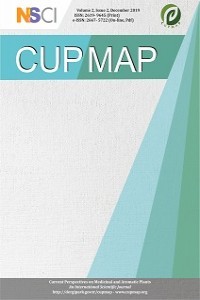Plant-Based Milk Alternative: Nutritional Profiling, Physical Characterization and Sensorial Assessment
Plant-Based Milk Alternative: Nutritional Profiling, Physical Characterization and Sensorial Assessment
___
- Ałtyn, I., and Twarużek, M., 2020. Mycotoxin Contamination Concerns of Herbs and Medicinal Plants. Toxins. 12(3). doi: 10.3390/toxins12030182.
- Aziz, M.A., Khan, A.H., Adnan, M., and Ullah, H., 2018. Traditional uses of medicinal plants used by Indigenous communities for veterinary practices at Bajaur Agency, Pakistan. J Ethnobiol Ethnomedicine. 14(1):11. doi: 10.1186/s13002-018-0212-0.
- BenJemaa, M., Falleh, H., Neves, M.A., Isoda, H., Nakajima, M., and Ksouri, R., 2017. Quality preservation of deliberately contaminated milk using thyme free and nanoemulsified essential oils. Food Chemistry. 217: 726-734. doi: 10.1016/j.foodchem.2016.09.030.
- BenJemaa, M., Hafsi, C., Falleh, H., Serairi Beji, R., and Ksouri, R., 2021. Essential Oils As Food Preservative: Encapsulation, Biological Activities, And Sensory Impact. In: The Seventh International Mediterranean Symposium on Medicinal and Aromatic Plants. ISBN: 978-605-61261-9-2.
- Dewanto, V., Wu, X., and Liu, R.H., 2002. Thermal Processing Enhances the Nutritional Value of Tomatoes by Increasing Total Antioxidant Activity. Journal of agriculture and food chemistry. 14,50(17):4959-64. doi:10.1021/jf0115589
- Jeske, S., Zannini, E., and Arendt, E.K., 2017. Evaluation of Physicochemical and Glycaemic Properties of Commercial Plant-Based Milk Substitutes. Plant Foods for Human Nutrition. 72(1):26‑33. doi: 10.1007/s11130-016-0583-0.
- Mäkinen, O.E., Wanhalinna, V., Zannini, E., and Arendt, E.K., 2016. Foods for Special Dietary Needs: Non-dairy Plant-based Milk Substitutes and Fermented Dairy-type Products. Critical Reviews in Food Science and Nutrition. 56(3):339‑49. doi: 10.1080/10408398.2012.761950.
- McNees, A.L., Markesich, D., Zayyani, N.R., and Graham, D.Y., 2015. Mycobacterium paratuberculosis as a cause of Crohn’s disease. Expert Review of Gastroenterology & Hepatology. 9(12):1523‑34. doi: 10.1586/17474124.2015.1093931.
- Munekata, P.E.S., Domínguez, R., Budaraju, S., Roselló-Soto, E., Barba. F.J., and Mallikarjunan, K., 2020. Effect of Innovative Food Processing Technologies on the Physicochemical and Nutritional Properties and Quality of Non-Dairy Plant-Based Beverages. Foods Basel Switz. 9(3). doi: 10.3390/foods9030288.
- Paul, A.A., Kumar, S., Kumar, V., and Sharma, R., 2020. Milk Analog: Plant based alternatives to conventional milk, production, potential and health concerns. Critical Reviews in Food Science and Nutrition. 60 (18):3005‑23. doi: 10.1080/10408398.2019.1674243.
- Sethi, S., Tyagi, S.K., and Anurag, R.K., 2016. Plant-based milk alternatives an emerging segment of functional beverages: a review. Journal of Food Science and Technology. 53(9):3408‑23. doi: 10.1007/s13197-016-2328-3.
- Silva, A.R.A., Silva, M.M.N., and Ribeiro, B.D., 2020. Health issues and technological aspects of plant-based alternative milk. Food Research International. 131:108972. doi:10.1016/j.foodres.2019.108972
- Siri-Tarino, P.W., Sun, Q., Hu, F.B., and Krauss, R.M., 2010. Saturated fat, carbohydrate, and cardiovascular disease. American Journal of Clinical Nutrition. 91(3):502‑9. doi: 10.3945/ajcn.2008.26285.
- Smedman, A., Lindmark-Månsson, H., Drewnowski, A., and Edman, A-K.M., 2010. Nutrient density of beverages in relation to climate impact. Food and Nutrition Research. 54. doi: 10.3402/fnr.v54i0.5170.
- Tapsell, L.C., Hemphill, I., Cobiac, L., Patch, C.S., Sullivan, D.R., and Fenech, M., 2006. Health benefits of herbs and spices: the past, the present, the future. The Medical Journal of Australia. 185(S4):S1‑24. doi: 10.5694/j.1326-5377.2006.tb00548.x.
- Thorning, T.K., Raben, A., Tholstrup, T., Soedamah-Muthu, S.S., Givens, I., and Astrup, A., 2016. Milk and dairy products: good or bad for human health? An assessment of the totality of scientific evidence. Food and Nutrition Research. 60:32527. doi: 10.3402/fnr.v60.32527.
- Vanga, S.K., and Raghavan, V., 2018. How well do plant based alternatives fare nutritionally compared to cow’s milk? Journal of Food Science and Technology. 55(1):10‑20. doi: 10.1007/s13197-017-2915-y.
- Wu, G., 2016. Dietary protein intake and human health. Food and Function. 7(3):1251‑65. doi: 10.1039/c5fo01530h.
- Yada, S., Lapsley, K., and Huang, G., 2011. A review of composition studies of cultivated almonds: Macronutrients and micronutrients. Journal of Food Composition Analysis. 24(4):469‑80. doi: 10.1016/j.jfca.2011.01.007.
- ISSN: 2619-9645
- Yayın Aralığı: Yılda 2 Sayı
- Başlangıç: 2018
- Yayıncı: Nazım ŞEKEROĞLU
Mariem BEN JEMAA, Rym GAMRA, Hanen FALLEH, Riadh KSOURI, Raja Serairi BEJI
Natural substances and coronavirus: review and potential for the inhibition of SARS-CoV-2
Amal HELALİ, Meryem Wafa HAMMADİ, Manal HOUALEF, Khadidja BENCHACHOU
R. Refika AKÇALI GİACHİNO, Betül AVCI
Hakan ÇETİNKAYA, İbrahim Samet GÖKÇEN
Antimicrobial Activity of leaf, fruit, and Gall extract of Pistacia terebinthus Growing in Tessala
Bellifa NAZIM, Ferkous HOUSSEM, Benhaddou ISMAIL, Merad YASSINE, Matmour DEROUICHA
